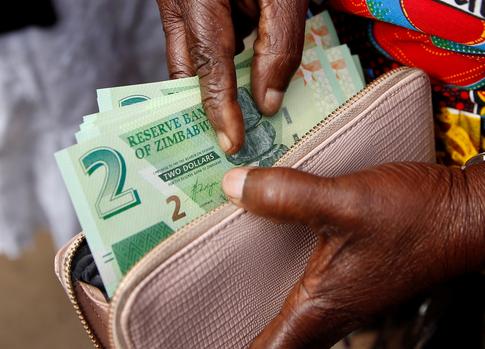Government Gazettes Update: 25th April to 18th May
This bulletin lists and briefly outlines the content of Statutory Instruments [SIs] and some General Notices [GNs] published in Government Gazettes from 25th April to 18th May 2020. Those SIs on which Veritas has already commented have links to the relevant Bill Watch bulletins.
Gazettes Extraordinary 25th April to 7th May
During this period the Government Printer continued publishing Gazettes Extraordinary only. This meant that there was no publication of the normal Friday legal notices about name changes, companies, deceased estates, etc. It also meant a substantial reduction in the number of gazetted tender notices, although a few tender notices from Ministries and state-controlled entities appeared in these Gazettes Extraordinary.
Wednesday 29th April
SI 96/2020 [link] – Deferral of Rent and Mortgage payments during COVID-19 National Lockdown
This SI contains regulations, made by the President under the Presidential Powers (Temporary Measures) Act, provides for a moratorium on rent and mortgage payments during the National Lockdown, and bans eviction from premises for failure to make such payments. In Bill Watch 24/2020 of 5th May [link] Veritas, with permission, set out and endorsed the Law Society of Zimbabwe’s published critique of the impact and legitimacy of these regulations, and added a few criticisms of our own. See also SI 97/2020 noted below for an amendment to these regulations gazetted only a few days later.
Thursday 30th April
GN 688/2020 [link] – Amendment to Clemency Order No 1/2020 re remission of prison sentences
This Gazette contained one General Notice [GN] only, making extensive amendments to Clemency Order 1/2020 signed by the President on 24th March [GN 673/2020 gazetted on 27th March 2020 [link]. Paragraphs 2, 3, 4, 5, 7 and 8 of the original order were replaced; paragraph 11(d) was amended; and a new paragraph 10A was inserted granting remission to
(1) all blind inmates. and
(2) other disabled inmates so physically challenged that they cannot be catered for in a prison or correctional environment.
As these amendments significantly increased the number of prisoners benefiting from remission of their sentences, we have prepared a consolidated version [link] of the Clemency Order reflecting the changes made – but also preserving the previous wording in footnotes. The footnotes will be an aid to understanding how the categories of beneficiaries have been extended.
Comment: GN 688 improved the lot of women and juvenile prisoners by deleting GN 673’s requirement that to qualify for full remission of sentence they should have served at least half or one-third, respectively, of their sentences. Similarly, GN 688 reduced from one-half to one-quarter the portion of sentence already served that would qualify a prisoner with a sentence of 3 years or less for full remission of sentence.
But this approach was not applied to the commutation of death sentences to life imprisonment, as it could have been. The 10-years on death row qualifying period fixed by GN 673 – itself repeated from an earlier clemency exercise – was left intact.
Saturday 2nd May
SI 97/2020 [link] – Amendment of Deferral of Rent and Mortgage Payments regulations – Creation of criminal offence
This SI added a new “offence and penalty” section to the principal regulations in SI 96/2020 [see above], making it a criminal offence for any person to cause or force the eviction of a tenant or mortgagor protected under SI 96/2020 for asserting his or her rights under the moratorium. This was a response to complaints that landlords were taking no notice of the ban on eviction for non-payment, and that the police were powerless to protect tenants in the absence of an offence and penalty provision.
SI 98/220 [link] – COVID-19 Regulations Amendment (No. 2)
This SI amends the regulations gazetted in SI 77/2020. See Bill Watch 23/2020 for more detail [link].
SI 99/2020 [link] – National Lockdown Order Amendment (No. 5)
This SI amends the lockdown order gazetted in SI 83/2020, including extending the lockdown until midnight on Sunday 17th May. See Bill Watch 23/2020 for more detail [link].
Monday 4th May
SI 100/2020 [link] – Excise Duties on Petroleum Fuels Amended
This SI amended, with effect from 5th May, the rates of excise duty applicable to petrol, diesel and kerosene.
Tuesday 5th May
SI 101/2020 [link] – National Lockdown Order Amendment (No. 6)
This SI amends the lockdown order gazetted in SI 83/2020. See Bill Watch 25/2020 for more detail [link].
Wednesday 6th May
SI 102/2020 [link] – National Lockdown Order Amendment (No. 7)
This SI amends the lockdown order gazetted in SI 83/2020. See Bill Watch 26/2020 for more detail [link].
SI 103/2020 [link] – COVID-19 Regulations Amendment (No. 3)
This SI amends the regulations gazetted in SI 77/2020. See Bill Watch 26/2020 for more detail [link].
Regular Gazette 44 of Friday 8th May
This Gazette marked the resumption by the Government Printer of publication of the regular weekly Friday Gazette. There were no SIs.
Gazettes Extraordinary of 8th and 14th May
Friday 8th May
This Gazette contained many GNs listening registered suppliers under the Public Procurement and Disposal of Public Assets Act and regulations.
Thursday 14th May
SI 103A/2020 [link] – New Ten and Twenty Zimbabwe Dollar Notes
By this SI the Minister of Finance and Economic Development gazetted the President’s authorisation to the Reserve Bank to issue new ten and twenty Zimbabwe dollar notes conforming to the specifications of colour, design and security features stated in the notice.
Regular Gazette 46 of 15th May
SI 104/2020 [link] – Collective Bargaining Agreement: Agricultural Industry: Tea and Coffee Sector
New wages in ZWL$ with effect from 1st November 2019.
SI 105/2020 [link] – Collective Bargaining Agreement: Agricultural Industry: Timber Sector
New wages in ZWL$ with effect from 1st November 2019.
SI 106/2020 [link] – Customs and Excise Suspension for SKD tricycle kits
This SI adds a new section 9LL to the principal regulations. It provides for a suspension of customs duty on semi-knocked down (SKD) tricycle kits imported by approved assemblers.
SI 107/2020 [link] – Customs and Excise Suspension Regulations: Amendment No. 231
This SI specifies mining location ME547-577, held by Rockrange Investments (Pvt) Ltd for purposes of section 9K of the principal regulations [3-year suspension of duty for capital development of a mine].
SI 108/2020 [link] – NSSA Pensions & Other Benefits Scheme – Rates of Benefits Notice Amendment No. 27 – “Increases” in Benefits
Before getting round to “increasing” pensions and benefits, this SI raises the rate of contributions from both employer and employee from 3½% to 4½% of employee’s insurable monthly earnings, with effect from 1st January 2020. The newly specified amounts for pensions and benefits are stated in ZWL$ amounts and replace amounts previously stated in US$. For instance, in section 3(b) of the SI the minimum invalidity pension is formally changed from US$ 30 to ZWL$ 80; it is only possible to regard this as an increase by reminding oneself that President Mnangagwa had in February 2019, by SI 33/2019, deemed US$ amounts specified in Acts and statutory instruments to be the same amounts in RTGS/ZWL$ – a feat of legislative legerdemain later confirmed by Parliament by the Finance (No. 2) Act, 2019 [link]. Note: A different provision in SI 33/2019 was recently declared unconstitutional by Justice Zhou in a High Court case, but the Minister of Finance and Economic Development has said the Government will appeal against his decision.
SI 109/2020 [link] – NSSA Accident Prevention & Workers Compensation Scheme (Prescribed Matters) Amendment – Increased benefits
This SI “increases” [see entry above] to ZWL$ 2 000,00 the funeral benefit for a worker who dies in an accident. Where a worker injured in an accident subsequently dies, NSSA will appoint a funeral services provider under a new provision. With effect from 1st October pensions on the payroll will be increased by 200% (or more, if that is necessary to bring them up to the new minimum pensions for workers (ZWL$240), widow/widower (ZWL$160), children (ZWL$30) or dependants (ZWL$53.33).
Gazette Extraordinary Sunday 17th May
SI 110/2020 [link] – National Lockdown Order Amendment No. 8: Lockdown extended indefinitely – but with relaxations
This SI is summarised in Bill Watch 29/2020 dated 17th May [link].
Gazette Extraordinary Monday 18th May
The two GNs making up this Gazette may be of interest to those with concerns about the Government’s procurement processes for COVID-19 essentials. The GNs notify Shortlisted Suppliers to the National Pharmaceutical Company [NatPharm] as at 18th May 2020. Both GNs invite parties interested in being added to the lists to contact NatPharm.
GN 861/2020 [link] – Personal protective equipment [PPE]
This GN lists not only the names of the shortlisted suppliers, but also the quantities involved, unit price, total price, country of manufacture and in some cases name of manufacturer.
GN 862/2020 [link] – Detergents, medical and surgical sundries
This GN, unlike SI 861 above, gives no details of unit price and total price.
Reminder: Documents Available on Veritas website
All SIs, GNs and Bill Watch bulletins referred to above are available for downloading on the Veritas website using the hyperlinks indicated.
Consolidated versions of the COVID-19 regulations [link] and the National Lockdown Order [link], incorporating the latest amendments, are also available on the website.
Veritas makes every effort to ensure reliable information, but cannot take legal responsibility for information supplied.
Post published in: Featured
















 Kathryn Rubino is a Senior Editor at Above the Law, and host of
Kathryn Rubino is a Senior Editor at Above the Law, and host of 
